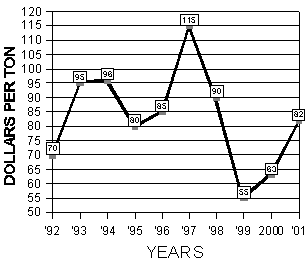Alfalfa Report
Yuma County, Arizona
July 16, 2001
Yuma County Office
2200 W. 28th Street, Ste. 102
Yuma, AZ 85364
(520) 726-3904
(520) 726-8472 FAX
Production Update:
PDF version, 14KB
Adding Moisture to Windrows: Producing high quality hay in hot, dry desert areas is a challenge due leaf loss when raking or baling. Growers typically wait for dew to appear late at night or early in the morning. Leaf losses can range from 5 to 10% even under the best conditions, and can be as high as 20% or more if the leaves become too dry. Windrow moisture can be increased by irrigating closer to cutting or by applying moisture to the windrow. Moisture can be applied to windrows with equipment as simple as a water truck or with specially designed spraying equipment.
Insect Management: Alfalfa looper, Autogragha californica (Speyer), is a minor pest of low desert alfalfa. Alfalfa looper larvae devour alfalfa leaves, but also occasionally feed on barley, cabbage, clover, grape, lettuce, peas and several weed species. Eggs are laid singly, larvae hatch within a few days, feed for about two weeks, and spin a loose white cocoon among the leaves to pupate. In about ten days to two weeks moths emerge. The entire life cycle is completed in about a month. Alfalfa loopers are rarely of economic importance in Arizona or California due to natural control. This insect is usually held in check by parasitic wasps, parasitic flies, and bacterial, fungal and viral diseases.
Weed Control: Season-long control of annual grasses can be expected
when 20 lbs. per acre of trifluralin 10G is applied in the spring. A second
application is sometimes necessary, however, where soils are not well
drained or water ponds in the field. Anarobic degradation of the herbicide
occurs under these conditions.
| Market Summary |
High
|
Low
|
Average
|
Off grade
|
| Past 2 Weeks ( July 2 to July 15, 2001) |
85
|
80
|
82
|
70-80
|
| Last Year ( July 2 to July 15, 2000) |
65
|
60
|
63
|
40-55
|
10 Year Summary (July 2, to July 15, 1992-2001):

Issued in furtherance of Cooperative Extension work, acts of May 8 and June 30, 1914, in cooperation with the U.S. Department of Agriculture, James A. Christenson, Director Cooperative Extension, College of Agriculture and Life Sciences, The University of Arizona.
The University of Arizona is an equal opportunity, affirmative action institution. The University does not discriminate on the basis of race, color, religion, sex, national origin, age, disability, veteran status, or sexual orientation in its programs and activities.
Any products, services, or organizations that are
mentioned, shown, or indirectly implied in this web document do not imply
endorsement by The University of Arizona.
Information provided by:
Barry Tickes, btickes@ag.arizona.edu Extension Agent, Yuma County
Michael Ottman, mottman@ag.arizona.edu Agronomy Specialist
College of Agriculture, The University of Arizona.
Eric Natwick, etnatwick@ucdavis.edu UCCE Imperial County - Farm Advisor
University of California, Davis, CA.
Material written July 16, 2001.
Forages: Crop Mgmt | Soil Mgmt | Irrigation | Alfalfa Reports | Insects | Diseases | Weeds | Pesticides
Home | Other Crops | Forages
For more Arizona Production Ag Information:
Home | Cotton | Veggies| Forages | Grains | Citrus | Crop x Crop | Insects | Diseases| Weeds | Pesticides | News | Weather | Research | Photos | Contacts | General Info. | Site Map
Copyright © 2001 University of Arizona,
College of Agriculture and Life Sciences
Webmaster: Al Fournier (fournier@ag.arizona.edu)